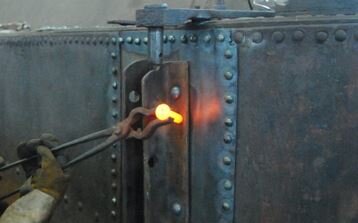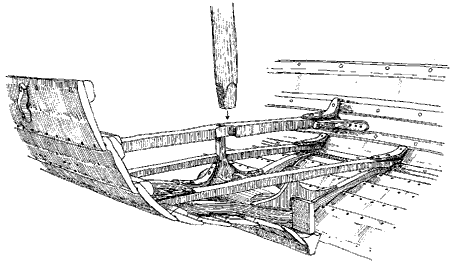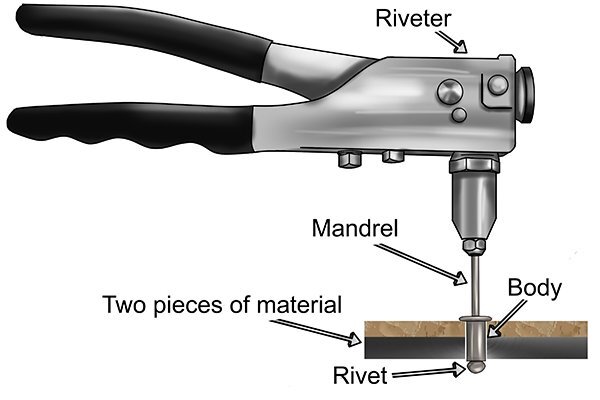History of Rivets & 20 Facts You Might Not Know
The term rivet is used to describe a variety of fasteners with a couple of common traits. They are pre-shaped at one end and have their other end reshaped when they are put to use. All have a smooth shaft that passes through the materials being bonded. They are used to join two or more materials together and form a joint that is stronger and tighter than a screw of the same diameter could be. Riveting is used in all types of construction today, metal is the most commonly riveted material. But wood, clay, and even fabric can also be riveted.
The best known type of rivet, the hot rivet, provides the strongest joints. In this process, glowing hot rivets are fed through precisely-drilled holes where the unformed end is hammered to close the joint. As the rivet cools, it contracts and squeezes the joint tightly together.
The story of the rivet is a fascinating trip through history. Here are 20 facts about rivets you may not know:
The first rivets appeared in Ancient Egypt over 5,000 years ago, where they fixed handles to clay jars.
By the time of the Ancient Romans, rivets were commonplace in construction.
Seventh-century Vikings used rivets to attach the planks of their longboats.
By the mid-19th century, advances in metal technology signaled the dawn of the modern riveting era. Riveting became the primary method for constructing metal tools, buildings, and vehicles.
Wrought iron, steel, and aluminum are the most common riveted metals because of their relatively soft composition.
Cast iron is impossible to rivet because it is so inflexible.
Bolts and welding are two other ways to attach metal together, and each has its use. Bolts are more versatile because they can be disassembled. Welding is more efficient, lighter, and versatile because it can attach a variety of shapes in many configurations. The downside to welding is that it affects the cellular structure of the metals being joined, and can create unwanted internal stress. Riveted joints are more flexible and give under changes in temperature.
The first common, modern application of the rivet was in boiler making.
The ship-building industry owes much of its early success to the process of riveting. Huge increases in maritime traffic between 1830 and 1940 boosted the use of the rivet.
There are two types of riveting: hot and cold. Cold riveting is used most often when small rivets are required. Hot rivets are typically larger, and used in large-scale construction like ships, boilers, and steam engines. These rivets are heated red-hot before installation.
By the mid-1800s rivets were being used in the construction of architectural buildings. Iron beams were riveted together, creating super-strong structures and paving the way for the skyscrapers of today.
Art and architecture utilized the rivet nearly as much as industry did. At the time of its construction in 1887, the Eiffel Tower in Paris was the tallest structure in the world. At 1,063 feet tall, the tower was formed by 18,038 pieces riveted together with 2.5 million rivets.
Other notable uses of rivets throughout history include the Golden Gate Bridge (1.2 million rivets), the Sydney Harbor Bridge (6 million rivets), and the RMS Titanic (3 million rivets).
On May 20, 1873, Levi Strauss secured a patent for his denim jeans with copper rivets. The rivets were meant to reinforce the pants at common stress points. To date, Levis has sold more than 200 million pairs of copper-riveted jeans.
Many World War II era tanks were riveted together, until weaknesses were found in that method of construction. Evidence from the field of battle demonstrated that the rivets could come loose if a large projectile hit the tank. The loose rivets would become small projectiles themselves, careening around inside the tank and causing injury to the soldiers.
Some drummers use special sizzle cymbals, which differ from regular cymbals in that they have several rivets attached to them. When struck, a sizzle cymbal’s sound is louder and sharper.
Ancient techniques for installing rivets utilized a hammer struck against a specialized tool called a bouterolle. This cup-shaped tool would help form the hammered end of the rivet into a mushroom-shape identical to the other end.
The advent of pneumatic tools made riveting more efficient. Today’s riveting process is done with special air-powered riveting guns that fire many times a second, hammering the rivet head into its final, mushroom shape.
Pop rivets are also known as blind rivets because one person can easily install them. Instead of hammering the rivet, a special riveting tool pulls the inside section flat.
The word “rivet” has its origins in Middle English and Old French, from the word “river” which meant to fix or clinch something.







